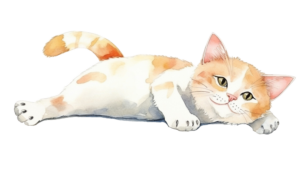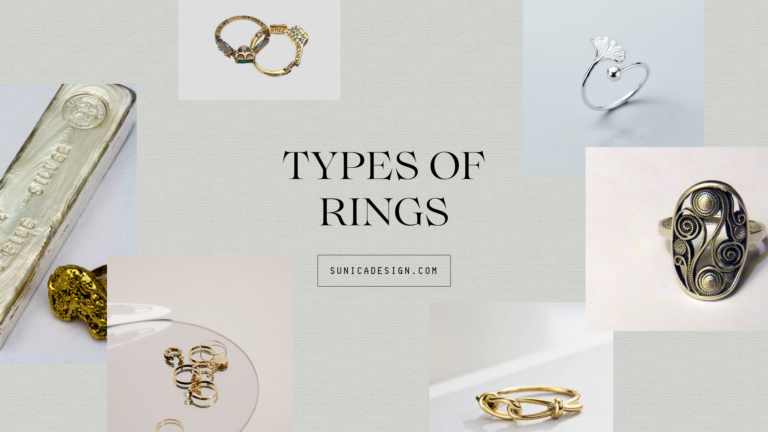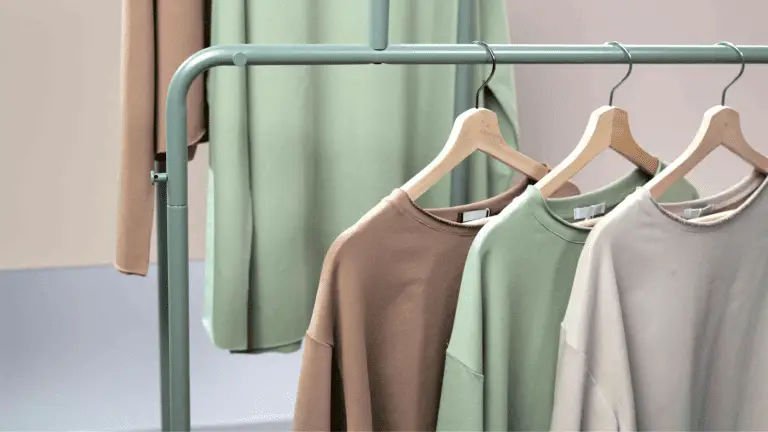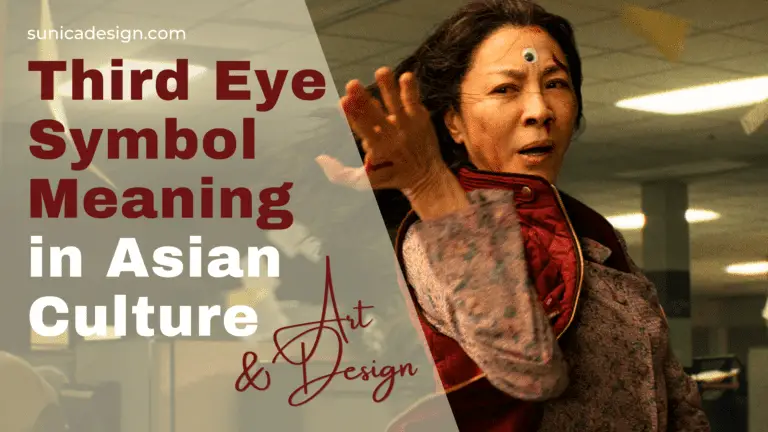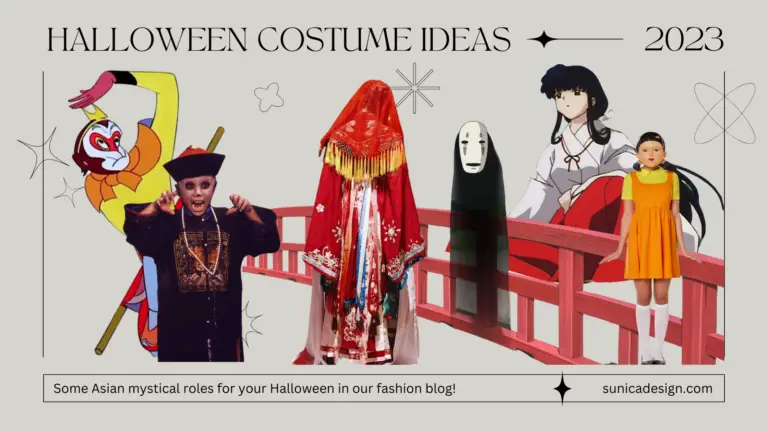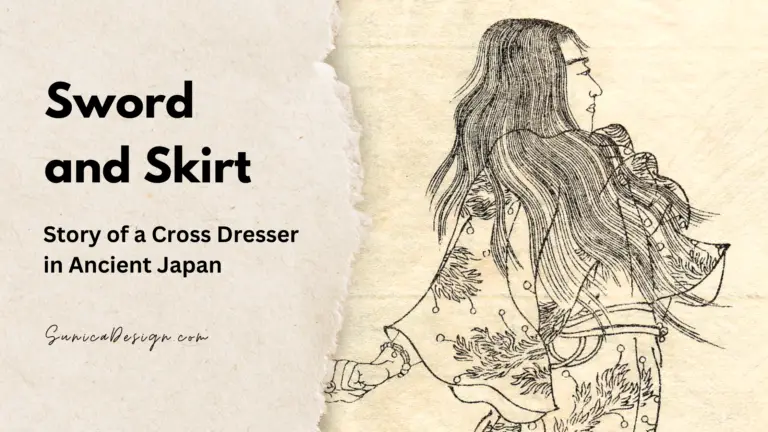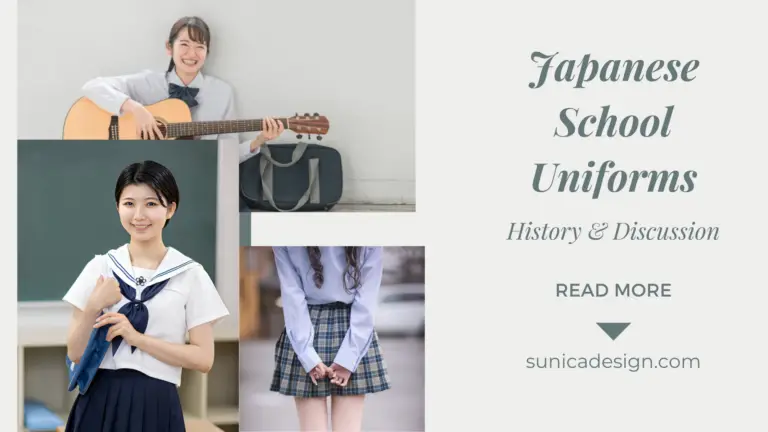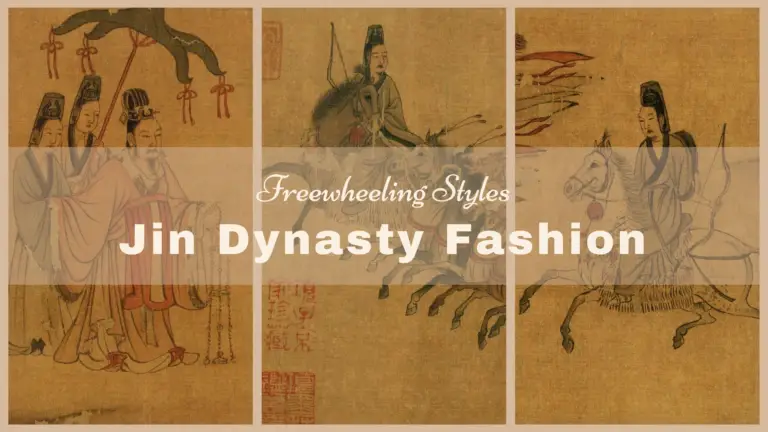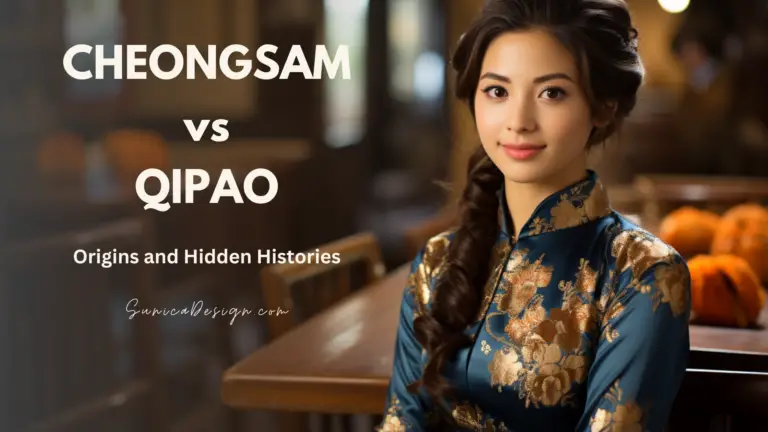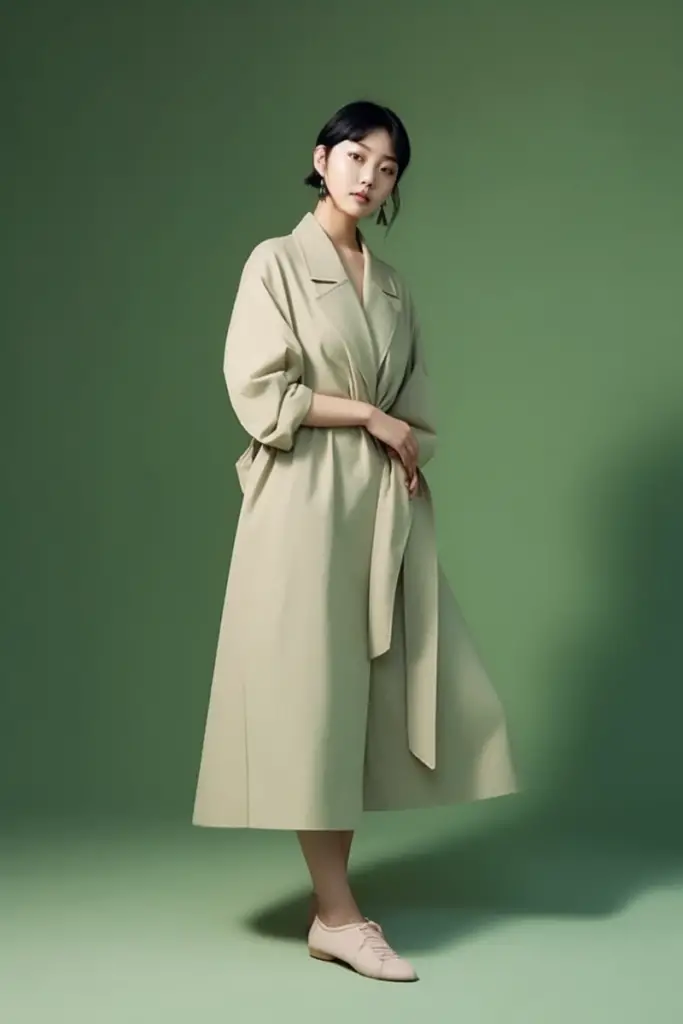Ahoy, landlubbers! Two sunsets ago, the rivers were churning, and the drums were banging in the name of the Dragon Boat Festival. If you missed the boat on what went down, don’t worry – we’re here to row you through the ins and outs.
Now, imagine a water chariot with a dragon‘s snout and a tail. From the thundering paddles to the lightning speed, dragon boating is like the Super Bowl of ancient Chinese traditions. Grab a paddle (or a snack), and get ready to ride this wave to Awesomeville!
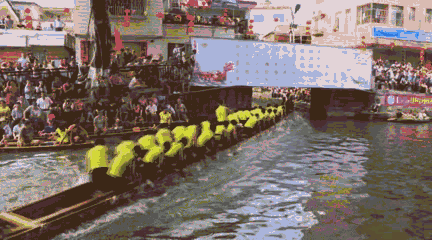
What Is Dragon Boat
A dragon boat, as the name suggests, is an elongated watercraft adorned with the emblematic figure of a dragon, which is deeply rooted in Chinese mythology. Typically constructed from wood, these boats range from 40 to 100 feet in length. The prow is intricately carved and painted to resemble a dragon’s head, while the stern takes the form of the dragon’s tail. The hull is usually narrow and streamlined, enabling swift and agile movement through the water.
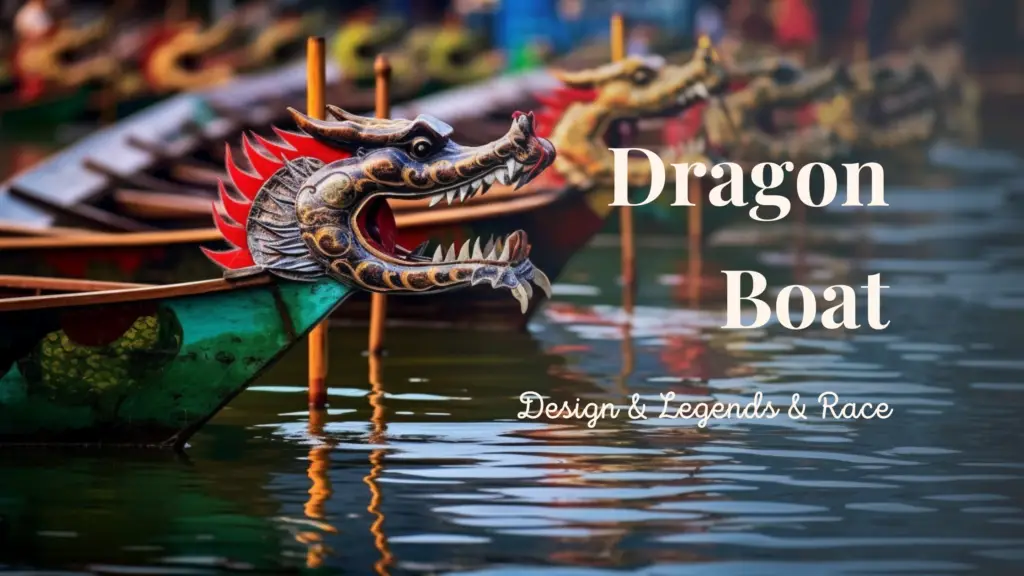
In the Dragon Boat Festival, known as the Duanwu Festival, teams of dragon boat paddlers, with a drummer at the helm, race through waterways to the rhythm of pounding drums. This captivating spectacle is not just a test of strength and coordination but also a reenactment of the historical attempt to rescue ancient poet Qu Yuan from the waters.
The Dragon Boat Design
As we continue to sail through the water of dragon boats, it’s time to take a closer look at what makes these vessels truly majestic – the design.
Hull
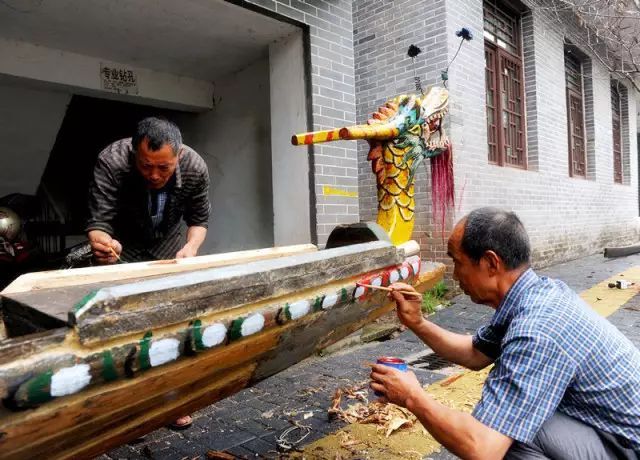
The hull, or “龙身”, is the primary section of a dragon boat responsible for carrying the crew. Traditionally, the hull is constructed from cedar or camphor wood, prized for their lightweight properties and resistance to insects and decay. Some communities will also use fir wood and teak wood for constructing the hull.
A dragon boat’s hull sports a shuttle-like shape, wider in the middle and tapering towards the ends, which slightly curve upwards. The hull width typically ranges from 1 to 1.6 meters. The dragon boats designed for performances have considerably wider hulls, while racing dragon boats have narrower hulls for high speed.
Just like other vessels, dragon boats feature compartments and planks. The planks are attached to the sides, dividing the boat into several compartments. The dragon boat also includes a keel, referred to as the “dragon bone,” which plays a crucial role in keeping the structure intact. Additionally, the keel divides the small compartments further.
Additionally, local craftsmen have mentioned that every newly constructed dragon boat is made slightly longer than the previous one as per village traditions, symbolizing longevity and continuous prosperity.
The Dragon Head
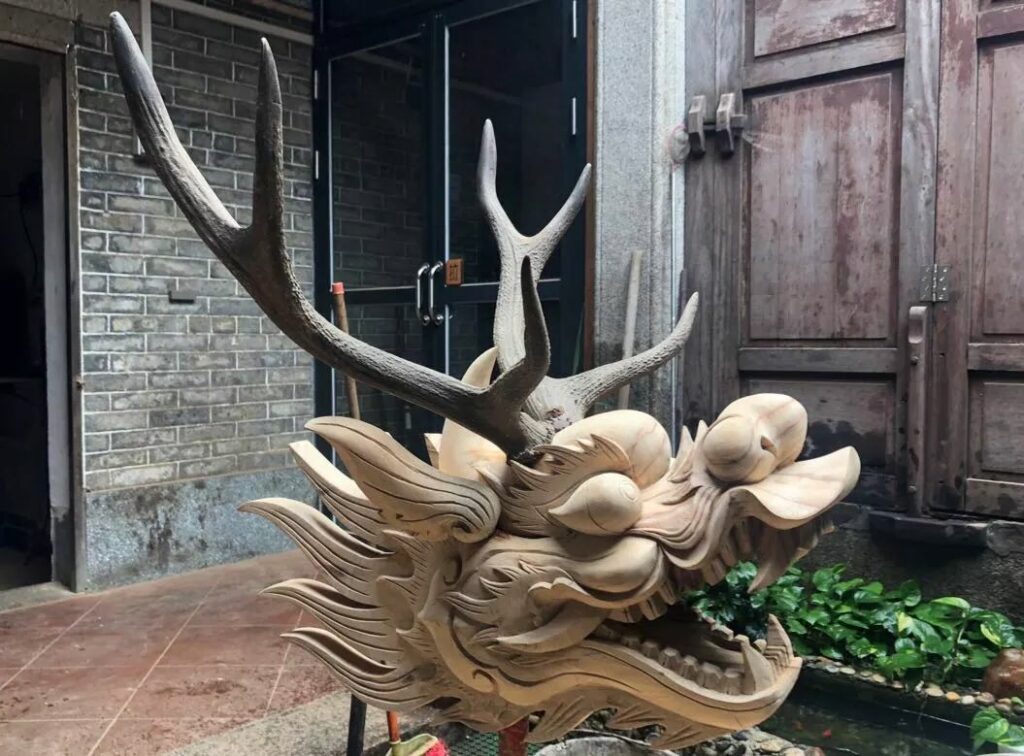
● Overall Outline
The dragon head, as the soul of the dragon boat, possesses the most complex and distinctive structure. It is composed of the horns, ears, eyebrows, forehead, nose, cheeks, aquatic whiskers, beard, tactile whiskers, hair, tongue, teeth, fangs, and lips. The horns resemble those of a deer, the ears mirror those of an ox, the nose is akin to that of a roaring lion, and the mouth is shaped like a tiger’s. The hair design is evocative of a horse’s mane. The overall shape of the dragon head is ferocious, embodying the dragon’s power and might.
● Three Types of Whiskers
Interestingly, there are three types of dragon whiskers: aquatic whiskers, beard, and tactile whiskers. The aquatic whiskers are depicted between the mouth and nose, often using decorative patterns. The beard is embedded in the chin area, and its length, density, and color are determined based on the dragon boat’s origin and age. The tactile whiskers are usually thin, curled, and must face upwards as this represents vitality.
● Symbolism
According to local artists, the style of dragon heads is customized based on the preferences of different teams. Each team has its own distinct characteristics. For example, in the old society, dragon boat teams that preferred dragon heads with white beards were generally older teams, indicating their friendly and non-confrontational nature. On the other hand, dragon heads with red or black beards were favored by teams that were more competitive and ambitious.
The selection of dragon head styles and colors is also influenced by the deities worshipped in the local. For instance, villages with temples dedicated to Guan Gong (the Red Face Lord) would choose red as the main color for decorating the dragon boat head.
The Dragon Tail
The dragon tail, much like the dragon head, is often carved from a single piece of wood. The tail is lively, realistic, and adorned with scales, but the colors can vary.
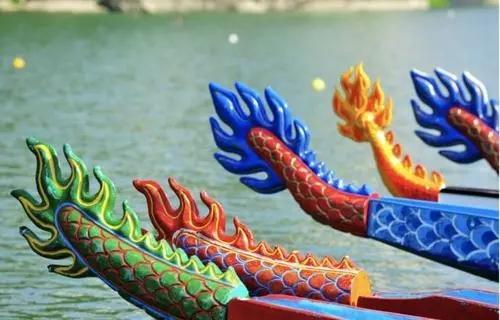
While the dragon head is more prominent and symbolically significant, the dragon tail tends to be simpler and less varied across different regions. In fact, many traditional dragon boats in the Lingnan region do not have a dragon tail. Instead, for large dragon boats, bamboo roots or shoots are tied at the stern to represent the tail.
However, in modern times, racing dragon boats generally feature dragon tails. This addition may be attributed to aesthetic preferences or competitors’ pride and love for their boats.
Paddles
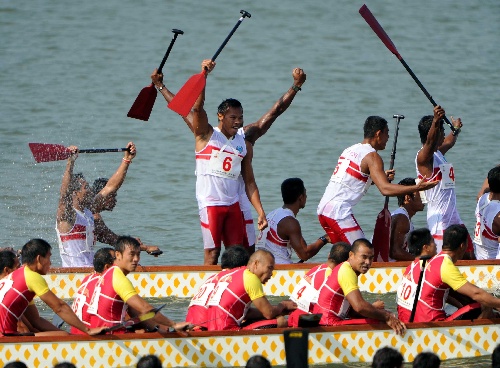
Finally, let’s steer towards the paddles. They’re specially designed with a teardrop shape to maximize efficiency.
Modern paddles often use carbon fiber, which is lighter and offers greater durability. The paddling in dragon boating is an art form requiring precision, rhythm, and most importantly, synchronization. The drummer at the helm sets the beat for the paddlers, ensuring that every stroke is part of a harmonious symphony of power and grace.
The Dragon Boat Festival
Now let’s take a detour into the calm and enchanting waters of the Dragon Boat Festival.
The Dragon Boat Festival, known as Duanwu Jie 端午节 in Chinese, is a yearly extravaganza that is observed on the fifth day of the fifth month of the lunar calendar. (Since this is the Chinese lunar calendar, it usually places somewhere in June.)
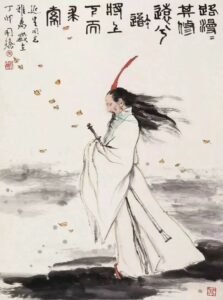
So, what’s all the hubbub about? Well, the Dragon Boat Festival is said to honor the famous poet and statesman Qu Yuan. This gentleman was quite the patriot, and when things went south for his beloved country, he couldn’t bear the heartache and drowned himself in a deep river. The local folks were a fan of his work, and they took to the river in boats, trying to recover his body, beating drums to scare away fish, and tossing rice into the water so that the fish would munch on that instead of their dear poet.
Ancient Dragon Boat Racing
In ancient times, dragon boat racing was not just a competition; it was an elaborate celebration woven into the fabric of community life. The racing took various forms, including dragon boat touring, dragon boat gatherings, and free-form racing.
Dragon Boat Touring
Dragon boat touring involved paddling the dragon boats to familiar neighboring villages, where communities had established relationships. Upon reaching a village, the participants would row the dragon boats up and down the river a few times before going ashore to rest, eat, or engage in conversations with acquaintances. During the journey, if multiple boats encountered each other, impromptu races were likely to happen. It is evident that in dragon boat touring, socializing and reveling in the festivity were the primary objectives, while racing was secondary.
Dragon Boat Gathering
Another widespread tradition was dragon boat gatherings combined with free-form racing in the ancient China. This usually occurred near larger villages and towns that were in proximity to rivers or lakes suitable for dragon boat racing. At the gathering points, if no organized races were taking place, the dragon boats were free to roam on the water. These gathering points often overlapped with the destinations for dragon boat touring.
Moreover, dragon boats at the gathering points may engage in performances, where rowing took on an expressive form. For example, in Guangzhou, paddlers would rhythmically plunge their oars into the water, causing sprays, while those at the front and rear of the boat would stomp their feet to create a rhythmic movement, mimicking a dragon frolicking in the water. In Yuhang County, Zhejiang, some dragon boats were manipulated to make the tail dip low in the water, which raised the dragon head, causing water to spurt from the dragon’s mouth as if it were a dragon inhaling clouds and exhaling rain.
Free-Form Racing
Like what we wrote above, free-form racing had a very casual and spontaneous nature. In some places, it involved two dragon boats racing, while in others, there were no restrictions on the number of participating boats.
In Shunde, Guangdong, there was a slightly more structured racing with designated starting points, finishing lines, lanes, and racing methods. However, it is still different from the modern dragon boat racing. The ancient races were based on traditional customs without specific or stringent rules regarding participants and boats.
Modern Dragon Boat Racing
In recent years, dragon boat racing has metamorphosed from an ancient Chinese tradition into an adrenaline-pumping global phenomenon.
Let’s talk numbers. The International Dragon Boat Federation (IDBF), which is like the United Nations of dragon boat racing, has over 60 member nations. That’s “taking the world by storm” kind of popular!
So, why is dragon boat racing bewitching so many people? For starters, it’s inclusive. You don’t need to be a six-foot-five, chiseled, athletic demigod. Dragon boat racing embraces people of all shapes, sizes, and fitness levels. Moreover, it’s a thrilling way to build team spirit. Office softball is cool, but steering a dragon through tumultuous waters with your colleagues – that’s next-level bonding!
Also, the boats themselves have evolved. While traditional dragon boats were carved from a single tree (yes, you heard that right!), modern ones are built with materials like carbon fiber and fiberglass, making them lighter and more hydrodynamic.
Besides, the race formats have changed. While traditional races were more about the journey, modern races are all about speed. It’s common to see dragon boats practically skipping across the water in a frenzy to cross the finish line now.
In a nutshell, modern dragon boat racing has embraced the thrill of competition, the camaraderie of teamwork, and a dash of showbiz.
Conclusion
Okay, let’s anchor down and take a breather. We’ve sailed through the intriguing depths of dragon boat history, marveled at the craftsmanship, and felt the pulse of modern racing.
What have we unearthed? Dragon boats are way more than just eye candy on water. They’re a cultural treasure chest, blending history with modern-day frenzy. From age-old traditions to the high-octane races, they’re like an everlasting firework display of unity and endurance.
The nifty design, the coordinated paddling, and the indomitable spirit – these are what make dragon boat racing the hot cake today. It’s not just a sport; it’s a buffet of life lessons served on a platter of water.


